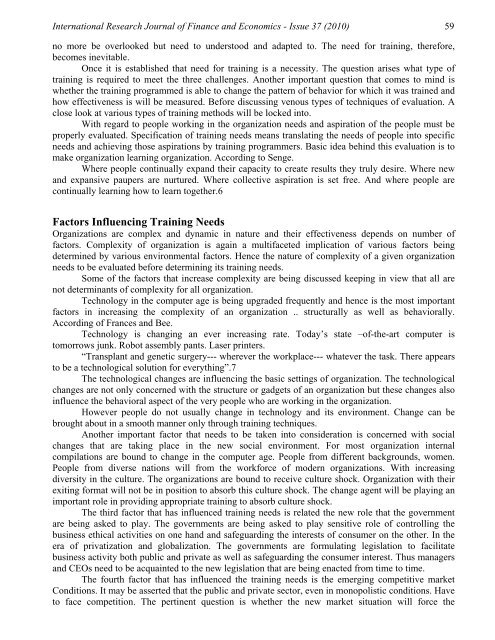Methods of Evaluation: Training Techniques - EuroJournals
Methods of Evaluation: Training Techniques - EuroJournals
Methods of Evaluation: Training Techniques - EuroJournals
Create successful ePaper yourself
Turn your PDF publications into a flip-book with our unique Google optimized e-Paper software.
International Research Journal <strong>of</strong> Finance and Economics - Issue 37 (2010) 59<br />
no more be overlooked but need to understood and adapted to. The need for training, therefore,<br />
becomes inevitable.<br />
Once it is established that need for training is a necessity. The question arises what type <strong>of</strong><br />
training is required to meet the three challenges. Another important question that comes to mind is<br />
whether the training programmed is able to change the pattern <strong>of</strong> behavior for which it was trained and<br />
how effectiveness is will be measured. Before discussing venous types <strong>of</strong> techniques <strong>of</strong> evaluation. A<br />
close look at various types <strong>of</strong> training methods will be locked into.<br />
With regard to people working in the organization needs and aspiration <strong>of</strong> the people must be<br />
properly evaluated. Specification <strong>of</strong> training needs means translating the needs <strong>of</strong> people into specific<br />
needs and achieving those aspirations by training programmers. Basic idea behind this evaluation is to<br />
make organization learning organization. According to Senge.<br />
Where people continually expand their capacity to create results they truly desire. Where new<br />
and expansive paupers are nurtured. Where collective aspiration is set free. And where people are<br />
continually learning how to learn together.6<br />
Factors Influencing <strong>Training</strong> Needs<br />
Organizations are complex and dynamic in nature and their effectiveness depends on number <strong>of</strong><br />
factors. Complexity <strong>of</strong> organization is again a multifaceted implication <strong>of</strong> various factors being<br />
determined by various environmental factors. Hence the nature <strong>of</strong> complexity <strong>of</strong> a given organization<br />
needs to be evaluated before determining its training needs.<br />
Some <strong>of</strong> the factors that increase complexity are being discussed keeping in view that all are<br />
not determinants <strong>of</strong> complexity for all organization.<br />
Technology in the computer age is being upgraded frequently and hence is the most important<br />
factors in increasing the complexity <strong>of</strong> an organization .. structurally as well as behaviorally.<br />
According <strong>of</strong> Frances and Bee.<br />
Technology is changing an ever increasing rate. Today’s state –<strong>of</strong>-the-art computer is<br />
tomorrows junk. Robot assembly pants. Laser printers.<br />
“Transplant and genetic surgery--- wherever the workplace--- whatever the task. There appears<br />
to be a technological solution for everything”.7<br />
The technological changes are influencing the basic settings <strong>of</strong> organization. The technological<br />
changes are not only concerned with the structure or gadgets <strong>of</strong> an organization but these changes also<br />
influence the behavioral aspect <strong>of</strong> the very people who are working in the organization.<br />
However people do not usually change in technology and its environment. Change can be<br />
brought about in a smooth manner only through training techniques.<br />
Another important factor that needs to be taken into consideration is concerned with social<br />
changes that are taking place in the new social environment. For most organization internal<br />
compilations are bound to change in the computer age. People from different backgrounds, women.<br />
People from diverse nations will from the workforce <strong>of</strong> modern organizations. With increasing<br />
diversity in the culture. The organizations are bound to receive culture shock. Organization with their<br />
exiting format will not be in position to absorb this culture shock. The change agent will be playing an<br />
important role in providing appropriate training to absorb culture shock.<br />
The third factor that has influenced training needs is related the new role that the government<br />
are being asked to play. The governments are being asked to play sensitive role <strong>of</strong> controlling the<br />
business ethical activities on one hand and safeguarding the interests <strong>of</strong> consumer on the other. In the<br />
era <strong>of</strong> privatization and globalization. The governments are formulating legislation to facilitate<br />
business activity both public and private as well as safeguarding the consumer interest. Thus managers<br />
and CEOs need to be acquainted to the new legislation that are being enacted from time to time.<br />
The fourth factor that has influenced the training needs is the emerging competitive market<br />
Conditions. It may be asserted that the public and private sector, even in monopolistic conditions. Have<br />
to face competition. The pertinent question is whether the new market situation will force the

















